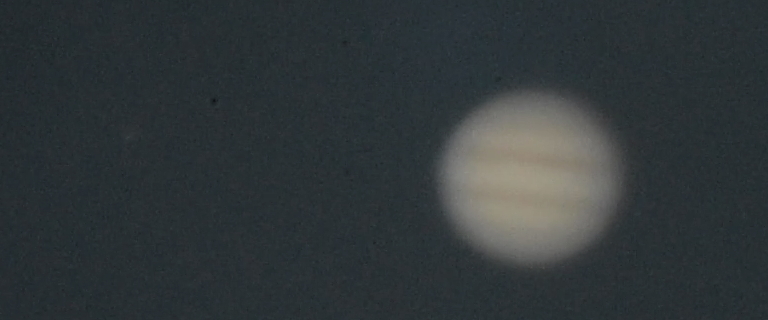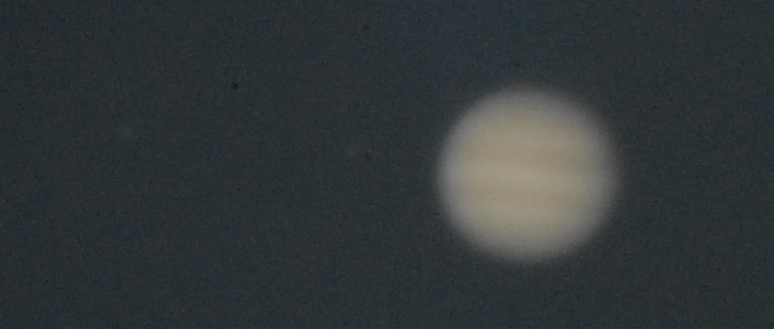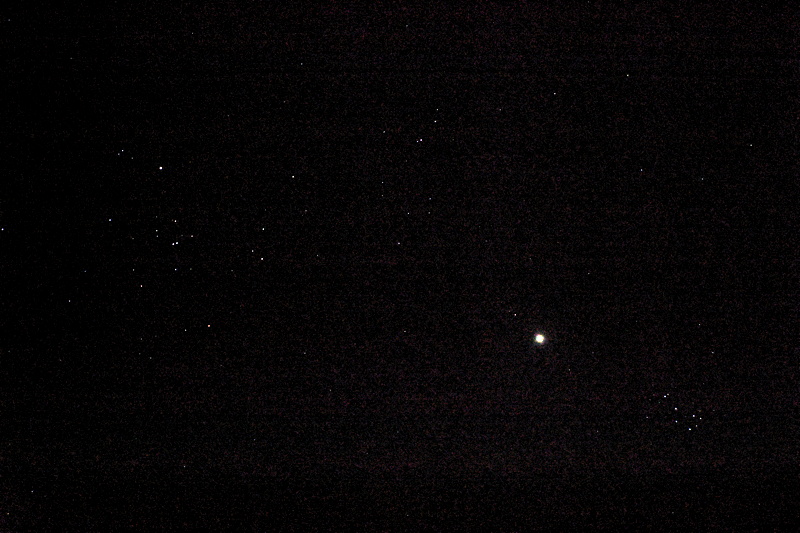Daylight Io eclipse of Europa, Venus, Critter
Posted: 14 April 2015
Although Thursday night, 9 April, was clear, I had to skip opening the observatory due a meeting of the Oracle Dark Skies Committee that evening and two events on Friday. Unfortunately, Friday, Saturday, and Sunday nights were cloudy so no observing. Monday, 13 April 2015, the sky finally cleared early in the day, although some cumulus clouds still moving in from the east mid-afternoon.
|
Open: Monday, 13 April 2015, 1803 MST Temperature: 87°F |
Session: 806 Conditions: Partly cloudy, clouds mostly in east |
1808 MST: viewed Venus, 83X. Then viewed Jupiter, 83X. Four moons were just barely visible against the bright blue sky as sunset would not occur until 1852 MST. Synced observatory clock to WWV for the eclipse of Europa by Io at 1828 MST. Mounted the D7200 DSLR on the 8" LX200-ACF for eyepiece projection 222X. 1822 MST: ready for imaging of Jupiter Moons Mutual Event. Seeing was not very good. No moons were initially visible in the camera viewfinder or on the Live View screen, but Io became visible at 1826 MST on the Live View screen.
I did a 6 minute HD video recording, 1.3X crop factor, at 60 fps, 1/60sec, ISO 3200. Here are three frames (cropped) from the video showing Europa disappear in the eclipse:
Pre-eclipse: Io (left), Europa (middle), Jupiter (right)

Mid-eclipse: Io (left), Europa (invisible), Jupiter (right)

Post-eclipse: Io (left), Europa (middle), Jupiter (right)

Imaging was hampered by the bright sky and poor seeing.
1842 MST: slewed to Venus and did a 30 second HD video recording, 1.3X crop factor, at 60 fps, 1/200sec, ISO 400. This is a stack of 1839 frames using Keith's Image Stacker:

1852 MST: sunset. Mostly clear now.
At 1858 MST: I heard and then saw a Harris's Hawk in a tree near the observatory. This 8 second video (reduced in size) was taken with an iPhone 5s:

Click or tap on image to see video
1920 MST: slewed back to Jupiter and did some observing, 83X and 222X. Four moons were still visible with Europa approaching the planet's disk.
At this time I began seeing lightning low in the northeastern sky from a storm a long distance away. 1939 MST: slewed to M42 (Orion Nebula). I checked to see if any nebulosity was visible using the Twitter Periscope livestreaming app; it wasn't, so didn't livestream the Orion Nebula.
1952 MST: slewed to M87 (galaxy), my first planned DSO imaging target for the night. It was faintly visible, 83X, 25 minutes before the end of Astronomical Twilight. Lightning was still appearing to the northeast and now to the southeast as well. Slewed to the star Denebola. Mounted the D7200 at prime focus + extension + off-axis guider. 2004 MST: clouds were now much higher in the eastern sky. Oops, the star Arcturus just disappeared. Did a focus test image on Denebola using the Bahtinov Mask and then slewed to M87. 2010 MST: M87 was now hidden by the clouds. Rats. The RadarScope app on my iPhone showed lots of rain in the area. By 2013 MST, the entire eastern half of the sky was now covered by clouds. Decided to close up.
2030 MST: the sky around Venus was still clear so I took this D7200 DSLR handheld photo, f/5, 1/5sec, ISO 25600, FL 66mm, showing Aldebaran and the Hyades at the left, Venus and the Pleiades at the lower right:

I really like this new D7200 DSLR. My review is still in work and I hope to be able to post it soon. I just need good weather to complete some DSO imaging tests.
2035 MST: sky was now mostly overcast.
|
Close: Monday, 13 April 2015, 2040 MST Temperature: 65°F |
|
Comments are welcome using Email. If you are on Twitter you can use the button below to tweet this report to your followers. Thanks.
Cassiopeia Observatory Home Page
Copyright ©2015 Michael L. Weasner / mweasner@me.com
URL = http://www.weasner.com/co/Reports/2015/04/14/index.html
